Degrees of freedom are a robot’s secret movement superpowers, basically telling you how many ways it can twist, turn, and navigate through space. Think of them like robot joints that let machines mimic human-like flexibility. More degrees of freedom mean your mechanical buddy can reach higher shelves, handle delicate objects, and perform mind-blowing precision tasks. Want to know how robots transform from clunky machines to nimble problem-solvers? Keep exploring.
What Is a Degree of Freedom in Robotics?
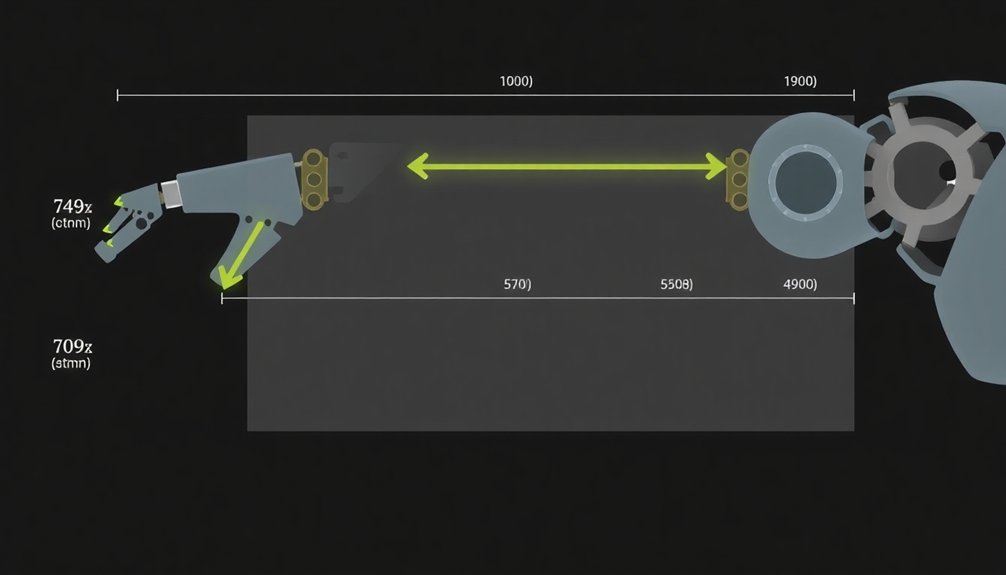
Imagine a robot as a mechanical dancer, and degrees of freedom (DoF) are its choreography moves. A degree of freedom is basically how many unique ways a robotic arm can twist, turn, and move in space.
Think of it like dance moves: the more moves you know, the cooler your performance. Robotic arms with multiple degrees of freedom can navigate complex environments like ninja warriors, reaching awkward angles and manipulating objects with precision.
A six-axis robot, for instance, can mimic human arm movements, bending and rotating just like you’d reach for a coffee mug on a high shelf. The more degrees of freedom, the more versatile and adaptable the robot becomes.
It’s like giving your mechanical friend extra superpowers of movement and flexibility. Humanoid robotics technologies demonstrate how advanced degrees of freedom enable robots to perform increasingly complex tasks across various industries.
Types of Robot Joints and Movement
Just like a robot’s degrees of freedom define its dance moves, its joints are the choreography’s building blocks.
Robot joints are the secret sauce that transforms rigid metal into something magical. You’ve got revolute joints spinning like tiny record players, creating rotational moves, and prismatic joints sliding like smooth subway doors for linear motion.
Most robotic arms rock a single degree of freedom per joint, which means each joint does one specific task really well.
Want maximum flexibility? Advanced robot designs pack six degrees of freedom, letting machines twist, turn, and manipulate objects with precision that would make a human gymnast jealous.
The right joint configuration isn’t just engineering—it’s an art form that determines whether a robot can paint a masterpiece or just shuffle awkwardly across a factory floor.
Proprioceptive sensors enable robots to fine-tune joint movements, enhancing precision and adaptability across complex tasks.
Degrees of Freedom Across Different Robot Types
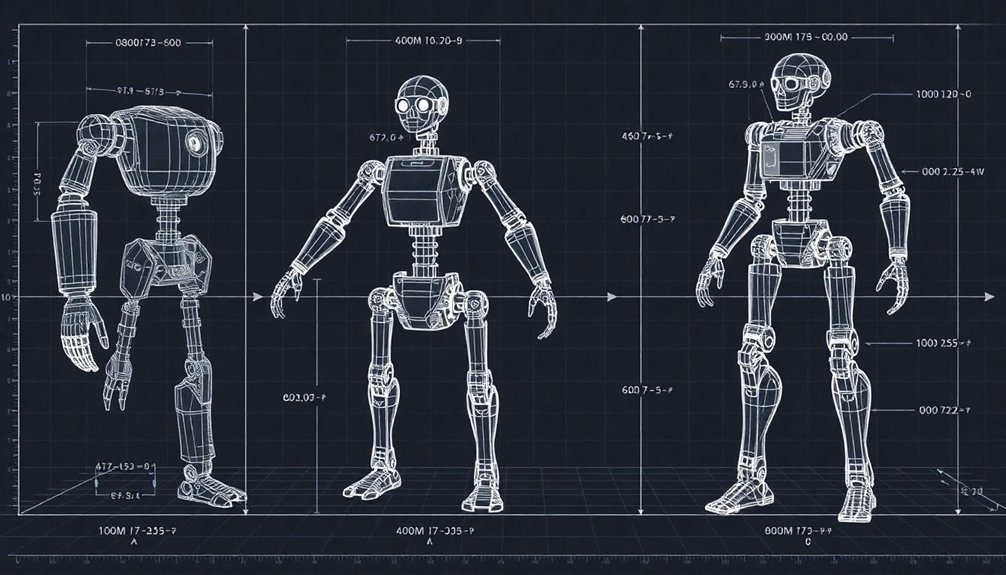
When it comes to robot movement, not all mechanical marvels are created equal.
You’ve got robots with varying degrees of freedom that determine just how wild their dance moves can get. Some, like SCARA and Cartesian robots, rock a solid three degrees of freedom, perfect for predictable assembly tasks.
Meanwhile, articulated robots flex six degrees of freedom, mimicking human arm movements like robotic gymnasts. Delta robots? They’re the speed demons, zipping through pick-and-place operations with precision.
Collaborative robots keep things interesting, adapting their freedom levels to work safely beside humans.
Think of degrees of freedom like a robot’s personality — some are rigid planners, others are flexible improvisers.
Which robot type would you want as your mechanical wingman?
How More DOF Impacts Robot Capabilities
Imagine a robot arm with enhanced DOF as your uber-flexible friend at a party who can:
- Reach the top shelf without a ladder
- Pick up a delicate wine glass without spilling
- Twist and turn through impossible angles
More degrees of freedom transform a clunky machine into a precision instrument capable of complex tasks. Proprioceptive sensors enable robots to understand their own body positioning with millisecond-level precision, enhancing their adaptive capabilities.
Your robot arm isn’t just moving; it’s performing surgical maneuvers or assembling microscopic components with human-like grace. Each additional axis isn’t just movement—it’s potential.
It’s the difference between a robotic arm that bumbles and one that performs like a virtuoso, adapting to challenges with split-second calculations and movements that make you wonder: Are we watching a machine or a mechanical maestro?
Real-World Applications of Robot Mobility
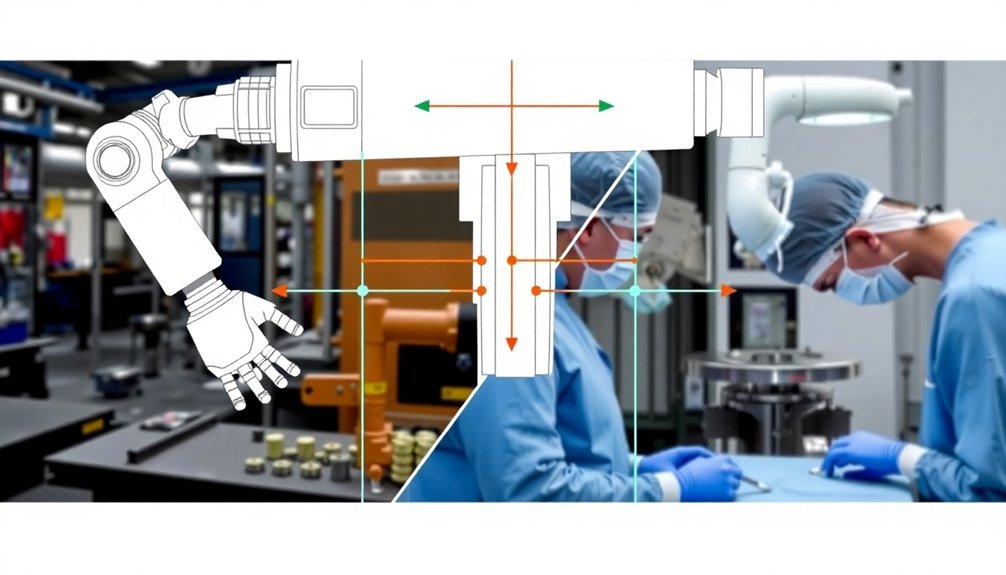
From precisely welding car parts in milliseconds to performing microscopic surgical procedures that human hands could never manage, robotic mobility is quietly revolutionizing what’s possible. Humanoid robots and companions are expanding the horizons of technological interaction, demonstrating how advanced mobility can transform emotional and practical support across various sectors.
Whether it’s a six-axis robot arm assembling complex electronics or a surgical robot performing delicate brain surgery, these machines are proving that more degrees of freedom means more human potential released.
Manufacturing Robotic Precision
Ever wondered how robots are transforming manufacturing with their superhuman precision? Industrial robots with six degrees of freedom are like mechanical ninjas, slicing through complex assembly tasks with razor-sharp accuracy. Robotic mechanical design incorporates advanced actuators and articulated joints that enable unprecedented movement sophistication.
These robotic arms can twist, turn, and position themselves in ways that would make a human gymnast jealous.
Check out their mind-blowing capabilities:
- Welding seams so perfect they look like they were drawn by laser
- Painting surfaces with millimeter-level consistency
- Packaging products faster than you can blink
Collaborative robots are the real MVPs, working side-by-side with humans while executing tasks that would drive most workers crazy.
They’re not just machines; they’re precision instruments that can adapt in real-time, using advanced sensors and AI to navigate manufacturing challenges like digital maestros.
Surgical Assistance Mobility
While traditional surgery once relied solely on human hands and limited tools, robotic surgical systems have dramatically transformed medical interventions, turning precise medical procedures into something that looks like science fiction meets high-tech engineering.
You’re witnessing a revolution where six degrees of freedom let robots navigate human anatomy like tiny, super-precise dance partners. Imagine surgical arms that can twist, bend, and move with superhuman accuracy, filtering out human tremors and amplifying a surgeon’s skills.
These robotic marvels aren’t just fancy gadgets—they’re game-changers that deliver surgical precision by replicating human hand movements with mechanical perfection. Less blood loss, faster recovery, fewer complications? It’s not magic; it’s advanced technology making medical miracles look almost routine.
Welcome to the future of surgery, where robots are the new surgical sidekicks.
Space Exploration Capabilities
Gravity’s Silent Rebel: Space exploration robots are the ultimate wilderness survival experts, minus the campfire stories.
These mechanical marvels with seven degrees of freedom aren’t just fancy metal arms—they’re precision instruments conquering alien landscapes.
Imagine these robotic arms maneuvering through:
- Jagged Martian terrain
- Zero-gravity satellite repairs
- Microscopic sample collection zones
NASA’s Perseverance rover proves robotic mobility isn’t just cool; it’s revolutionary.
By leveraging multiple degrees of freedom (DOF), these robotic arms perform surgical-like manipulations where humans can’t tread. They analyze soil, capture instruments, and explore environments that would make human explorers weep.
Want to understand extreme adaptability? Watch a robotic arm twist, turn, and probe where no human hand could ever reach.
These machines aren’t just tools—they’re our interplanetary ambassadors of curiosity.
Calculating Degrees of Freedom in Robotic Systems
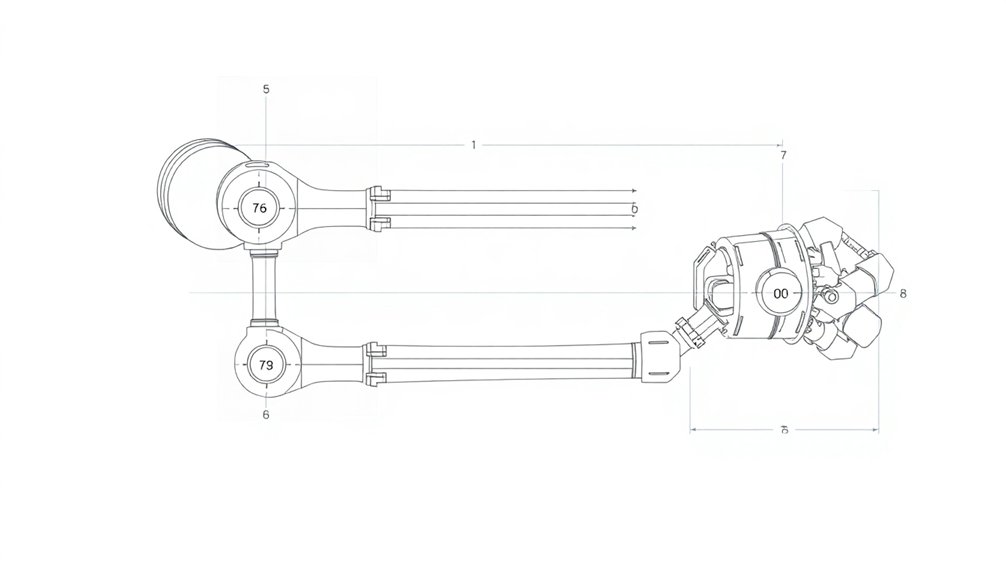
When you’re trying to figure out how a robot moves, you’ll need to crack the code of its degrees of freedom—think of it like mapping out a machine’s dance moves.
You’ll start by analyzing motion constraints, which means understanding how each joint contributes to the robot’s total mobility, like counting the individual steps in a complex choreography.
Motion Constraint Analysis
Because robots aren’t just sci-fi fantasy anymore, understanding how they actually move becomes critical.
Motion constraint analysis helps engineers decode a robot’s potential for independent movements. Imagine a mechanical marvel with precise degrees of freedom that dictate its dance across complex landscapes.
Here’s what makes robotic motion mind-blowing:
- Each joint’s unique movement creates a symphony of mechanical precision
- Constraints transform raw mechanical potential into targeted functionality
- Rotational and translational movements reveal intricate robotic capabilities
Joint Freedom Calculation
Ever wondered how engineers transform metal and circuits into machines that can dance, grab, and navigate like living creatures? Degrees of freedom is the secret sauce.
When you’re calculating a robot’s potential moves, you’ll track its number of joints and how each one contributes. A revolute joint gives you one degree of rotational freedom, while different joint types reveal varied motion possibilities.
Imagine a robotic arm: its shoulder might offer three degrees of freedom, the elbow one, and the wrist another three. That’s how engineers craft machines with seven total movement options.
The magic formula? DOF = 6N – J – H, where N represents links, J means joints, and H tracks higher constraints.
It’s like mathematical choreography, turning rigid components into fluid, adaptable machines.
Robotic System Complexity
Robots aren’t just sophisticated machines—they’re complex choreographies of motion, where every link and joint tells a mathematical story of potential movement. Understanding a robot’s degrees of freedom isn’t just technical mumbo-jumbo; it’s about decoding its mechanical DNA.
Imagine a robot’s complexity as a dance of potential:
- Each link is a performer, waiting to move
- Joints are the choreography connecting those performers
- Constraints are the invisible boundaries of the stage
Calculating a robot’s complexity isn’t rocket science (well, sometimes it is). The DOF formula—3N – J – 2H—reveals how many ways your mechanical friend can wiggle, twist, and navigate its environment.
It’s like a mathematical personality test for robots, showing exactly how much creative motion they’ve got packed into their mechanical bones.
Future Trends in Robotic Mobility and Design
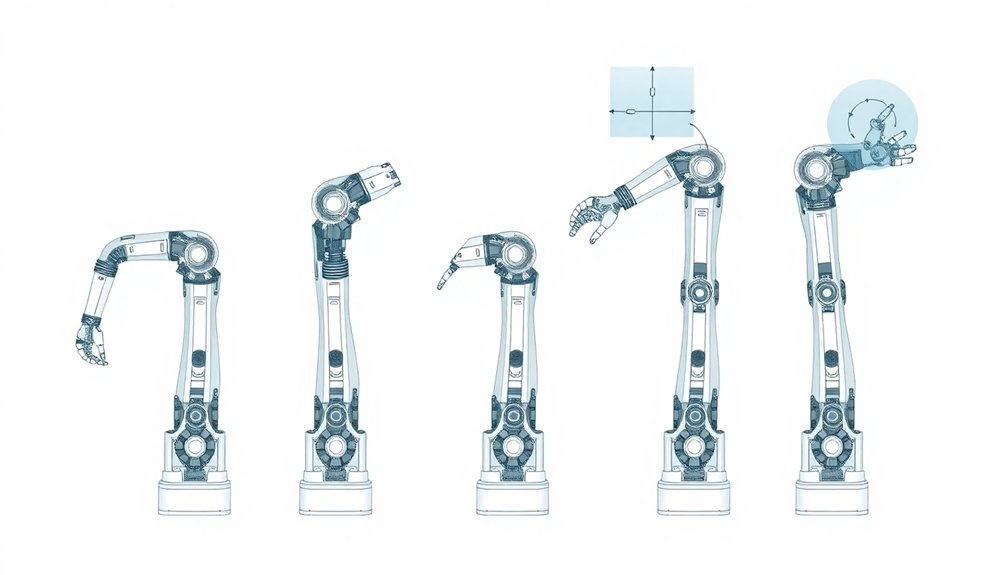
As the boundaries of robotic technology continue to stretch, the future of mobility and design looks less like a sci-fi fantasy and more like an impending reality. You’ll witness robots gaining unprecedented freedom through soft materials and bio-inspired designs that transform movement. Imagine snake robots slithering through complex environments with AI-driven precision!
| Trend | Impact |
|---|---|
| Soft Robotics | Enhanced Adaptability |
| Bio-Inspired Design | Versatile Movement |
| AI Integration | Real-Time Learning |
| Exoskeleton Tech | Human Collaboration |
These advances aren’t just cool tech—they’re game-changers. Autonomous robots with increased degrees of movement will revolutionize industries from healthcare to manufacturing. Think robots that learn, adapt, and navigate like living organisms. Wild, right? The future isn’t about replacing humans; it’s about creating intelligent machines that complement our capabilities in ways we’re just beginning to understand.
People Also Ask About Robots
What Is the Significance of Degree of Freedom in Robotics?
You’ll find that degrees of freedom determine a robot’s movement complexity, enabling precise manipulation and task versatility across industries by defining how many independent motions a robotic system can independently perform.
What Are the 6 Degrees of Freedom in Robotics?
Ever thought you’d need a robot PhD? The 6 DoF include three translational moves (x, y, z) and three rotational twists (around x, y, z), letting your robotic buddy navigate space like a pro, mimicking human-like precision.
What Is the 7 Degrees of Freedom Robotic Arm?
You’ll find a 7 DOF robotic arm adds an extra joint, enabling more complex movements like reaching around obstacles and mimicking human-like motions with enhanced precision and flexibility in tasks like surgery or manufacturing.
How Many Degrees of Freedom Should a Robot Have?
You’re the architect of motion: your robot’s degrees of freedom depend on its mission. From 3 DOF for simple tasks to 6+ for complex manipulation, choose wisely to release your machine’s potential and precision.
Why This Matters in Robotics
As robotics evolves, you’ll see how degrees of freedom transform machines from rigid tools to adaptive problem-solvers. Imagine a surgical robot with 7 DOF precisely maneuvering complex human anatomy, saving lives millimeter by millimeter. We’re not just building machines anymore—we’re creating intelligent extensions of human capability that can think, adapt, and move in ways we’ve only dreamed of. The future isn’t about replacing humans; it’s about empowering them.
